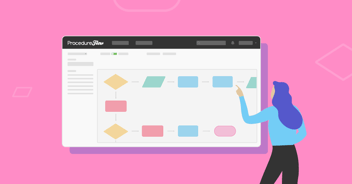Procedures vs Processes: What They Mean and Why You Need Both to Be Successful

At first glance, trying to distinguish the difference between procedure and process has a bit of a chicken-and-egg feel to it. You can’t have one without the other, but which one comes first? It’s important to differentiate procedures vs. processes because although they are companions, they have distinct attributes that require their own consideration. Many people use these two terms as if they’re interchangeable, but they’re not. Let’s sort them out.
What is the difference between procedures and processes?
The process comes first. It’s a high-level view. Procedures are step-by-step instructions to execute the process. Another way to think of it is that a process is a thing you do, and the procedure is the way you do the thing you do.
I write articles for online forums. Article writing is the process, beginning with a blank document and ending with an article. The process requires inputs (from the keyboard) and an output (the finished document).
My procedure for writing an article:
- Receive topic from Editor.
- Research.
- Pour coffee.
- Scour the Internet for funny cat videos.
- Open a minimum of 20 browser tabs.
- More research.
- Write an article.
- Check email.
- Google dinner recipe ideas.
- Pour another coffee.
- Rewrite article.
- Run spell-and-grammar-checking app.
- Submit an article to Editor.
Another article writer would probably have different procedures for the same process. I would urge them to not skip the crucial cat-video step. It’s important to clear the mental palate.
You, as a business owner or manager, need everyone in your organization to follow the same procedures for each process to achieve and maintain consistently high-quality performance from your staff, for your customers. Because not following the procedures means someone might miss a crucial step that could have a negative impact on the outcome of the process.
What is the definition of a process?
The International Organisation for Standardization (ISO) defines a process as a set of interrelated or interacting activities which transform inputs into outputs.
A process is what you do.
What is the definition of a procedure?
Again, from the ISO: A procedure is a specified way to carry out an activity or a process.
A procedure is how you do what you do.
What is an example of a process?
Let’s zero in on an example of procedures vs. processes.
You’re planning to drive from Chicago to Seattle. Driving time is estimated at about 30 hours. Your input is beginning in Chicago and your output is enjoying a Grande Caffè Latte at the first Starbucks location at Pike Place Market. That’s the process.
The specifics of how you’ll execute the long drive is the procedure. You’ll probably start with a visit to a gas or charging station. You’ll need to break it up into manageable lengths of time spent behind the wheel, stop for food and breaks, find places to stay overnight, etc.
For another example, let’s use a call center. An agent taking a call is the process. The input is the incoming call, and the output is the resolution to that call. But as we know, call centers and contact centers can receive hundreds and sometimes thousands of different types of calls. Each of those calls is a process. You would begin with process mapping and drill down to the steps required to complete those calls to your definition of satisfaction. Within those processes are specific, distinct procedures.
This is where ProcedureFlow makes a significant impact. ProcedureFlow is a cloud-based knowledge management solution. The solution converts organizations’ processes and information into an accessible easy-to-use management tool to be used by employees.
By turning each process into easily consumable action flows, ProcedureFlow standardizes best practices in procedures across your whole team. And by following the flows, employees ensure consistent delivery of service, every time. Essentially, this knowledge management solution will help optimize standard results, minimize errors, and increase staff productivity throughout your organization.

How to get everyone to follow the procedures
Incentives are great. Everyone enjoys rewards. But on a fundamental level, convincing staff to follow your organization’s procedures can be as easy as one, two, three.
- Explain the reasons for using them. When employees can see only the small-picture results of a big-picture plan, they might end up feeling burdened rather than supported. “We have to change the way we do everything. WHY?!” Answer the “why” before it’s even asked. Give lots of notice before implementing changes. Ensure they understand that following procedures is about more than just the company’s bottom line. (Although it’s certainly about that, too.) Highlight the benefits to them, from improving their workflows to making them more effective at serving customers. Most people want to be successful in their work.
- Bring them into the fold. Employees tend to feel a sense of ownership when they’ve been asked to contribute their ideas and opinions to a project. Create a panel or panels of team members and ask them to invest their insight and experiences into the development of procedures and processes. With ProcedureFlow, they can suggest updates or changes to flows that you can instantly approve, further enhancing their engagement. This has a positive peer pressure element to it, as well. Once there’s a buy-in, those involved will police their colleagues for compliance.
- Provide them with the best available tools. No more passing around The Binder, hurriedly scratching out reminders on scraps of paper or putting customers on hold to ask the supervisor a question they’ve been repeatedly asked already today. With ProcedureFlow, all team members have easy-to-follow guides for their processes at their fingertips. And they are available when an employee needs them—even if others are using them at the same time. Instant access means better efficiency which leads to improved job satisfaction and consistently excellent customer experiences.
ProcedureFlow also allows you to monitor team members’ usage, giving you an opportunity to coach those who are falling behind.
Conclusion
Understanding the distinctions of procedures vs. processes will help you to determine how to establish and organize your company’s workflows and best practices. The experienced management optimization experts at ProcedureFlow are ready to assist you with disseminating that information to your team in a simple and effective way. From removing ambiguity and thereby increasing employee confidence, to less training time for new hires, the benefits are numerable and verifiable.
Request a demo and see how you can get started with ProcedureFlow today.
Written by Lisa Brandt.


